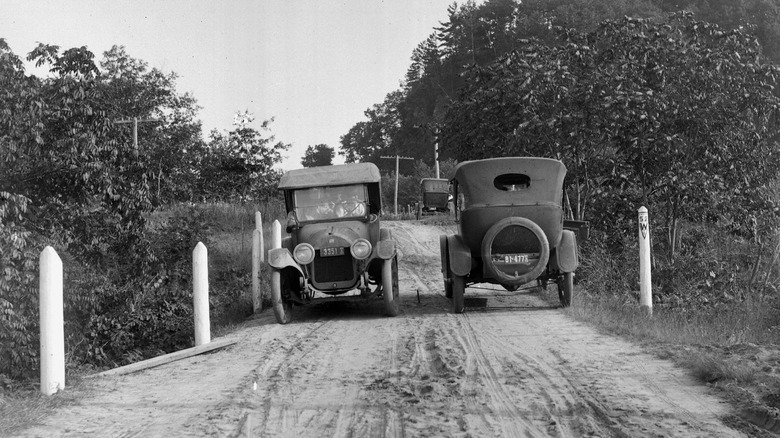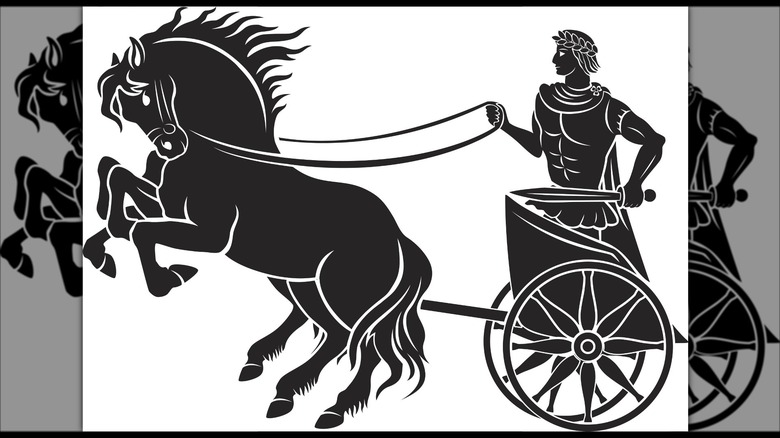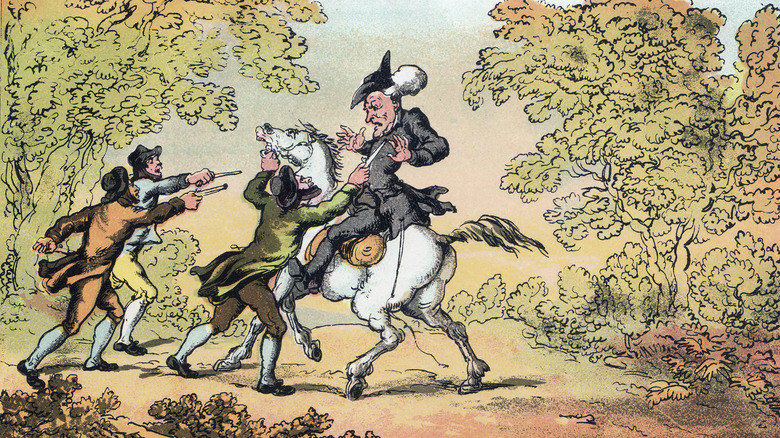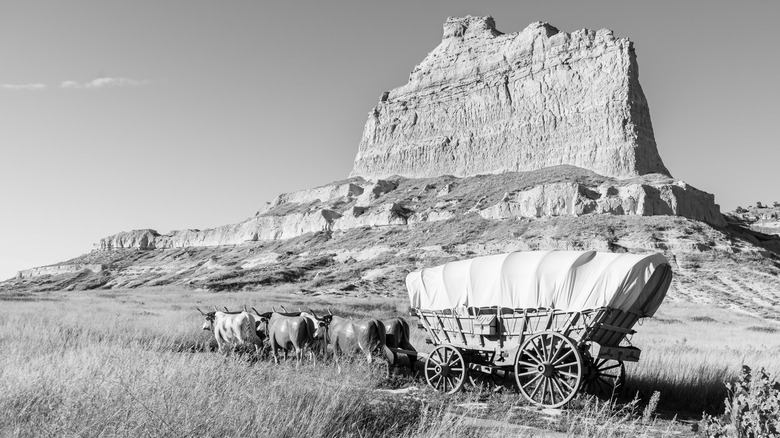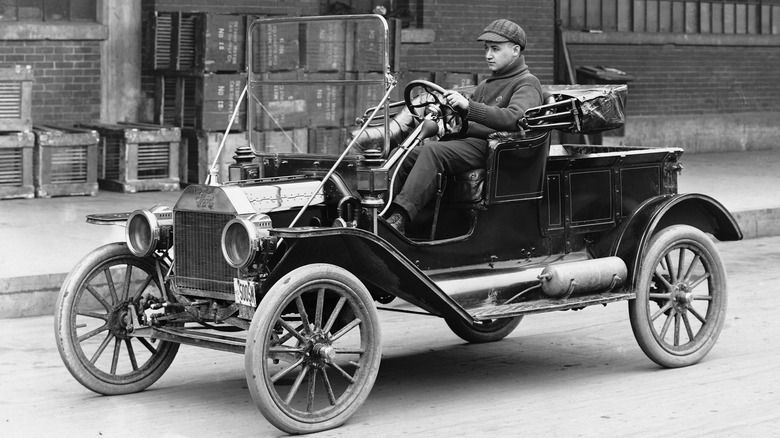Why Do Americans Drive On The Right Side Of The Road?
While that might seem like a straightforward question, the answer is a rather long and winding road if you'll forgive the pun. Back when you were first learning to drive, your instructor probably taught you how to use turn signals properly, the appropriate "10 and 2" position for your hands on the steering wheel, how many car lengths were safe to follow behind another car, the proper hand signals to use while driving without tail lights, and a whole laundry list of other road rules. But were you ever told why we drive our vehicles on the right side of the road?
According to Insider, some 163 countries (and territories) drive on the right side, while only 76 (or about 30% of the world) drive on the left. Meanwhile, National Geographic puts the number of right-sided driving nations at 75%, with those who stick to the left side comprising the United Kingdom and many of its colonies or former colonies, including those in Southeast Asia, Southern Africa, and Oceania.
Great, but why? Glad you asked. Pop quiz time! What do chariots, an old-time covered wagon, and humans being predominantly right-handed have to do with which side of the road we drive on? As it turns out, pretty much everything. Let's hop into the Wayback Machine for a trip back to a place and time long before the modern-day auto (in this case, Karl Friedrich Benz's three-wheeled "car" powered by a gas-fed internal combustion engine in 1885) was yet undreamed.
Human genetics paved the way
In the BCE (Before the Common Era) days of the Roman Empire, Legionnaires tore across the land aboard horse-powered chariots. These were driven by charioteers, who commonly held the reins in their right hand while wielding a whip to make the horses go faster in their left.
It's a generally recognized fact that about 90% of humans are right-handed, with a mere 10% being lefties. This oddity of genetics can be attributed to the fact that the brain's left hemisphere controls the right side of the body, while the right hemisphere controls the left.
One theory suggests that during the evolutionary process of making stone tools, which were "invented" more than once throughout history, homo sapiens used their right hands more because the cognitive force that drives tool-making comes from the left half of the brain. Another hypothesis states that, thanks to our basic need to survive, we knew on some deeper level that competition and cooperation needed balance in order for the species to coexist and flourish. A common denominator between most divergent groups was that everyone was right-handed, and to promote the sharing of ideas and resources, everyone stayed that way. Curiously, most primates don't favor one side over the other as much as humans.
Given all that, the charioteer holding the whip in his left hand led to chariots passing on the right side to avoid getting smacked. Therefore, the Romans are credited with inventing the European model of driving on the left side of the road.
Highway robbery has been around a long time
Fast-forward to the Colonial Period in America, which started when the first English colony at Jamestown was established in 1607. Within just a few decades, a multitude of additional colonies had sprung up in the surrounding areas that would become known as New England, Maryland, and Virginia. Part and parcel of that expansion was the use of horse or ox-drawn wagons.
As we began to spread across the continent, something odd started to develop. In Old World Europe, wagons, horse riders, and pedestrians — that's how most people got around back in the day — all tended to go about their merry way on the left side of the road — because Romans. However, those who now lived in the New World did things just a little differently.
According to research done by Albert C. Rose, the "unofficial historian" for the U.S. Bureau of Public Roads, right-handed travel has been part of America since the early colonies. Most people during that dangerous period of our history traveled with handguns nestled neatly in the hollows of their left arm.
This naturally led people to move about on the right side of the path or trail (remember, there were technically no "roads" per se), which allowed them to react quicker if attacked by nefarious highwaymen. There was also the notion that many of the colonists quite literally bore a grudge (a "smoldering opposition," as Rose put it) against the customs of the Old World, which drove them to establish their own.
The Conestoga wagon helped lead the way West
In 1750, a heavy-duty covered wagon began to appear on trails in the Conestoga River area of Pennsylvania's Lancaster County. It could haul up to six tons and was pulled by a team of four to six horses (or oxen). Built by Mennonite German settlers, the floors were designed to curve upwards on either end to keep things in place. A distinctive white canvas top stretched over wooden hoops protected the contents, making the Conestoga wagon look like a ship, earning the nicknames "inland ship of commerce" and "prairie schooner."
This landship had no exterior seats, so the driver (called a teamster) had to ride one of the horses or walk next to the wagon. If he needed a break, a small "lazy board" on the left side between the front and rear wheels could be pulled out and sat on. This early version of a jump seat was conveniently located near the brake lever.
Given that layout, the driver typically stood behind the left-wheel led horse(s), holding the reins with his left hand and working the horses (or operating the brake lever) with the right. Drivers kept these big rigs on the right side of thoroughfares because it gave them a better view of the clearance between wagons as they passed each other. Over the next century, the Conestoga became the wagon to own and the very symbol of Westward Expansion, further cementing the American custom of driving on the right side of the road.
Rules of the road
The first "official" American rules of the road appeared in 1792 when Pennsylvania — the same place the Conestoga came from — enacted legislation to build a turnpike between Lancaster and Philadelphia, which opened in 1795. The fine print included verbiage stating that all travel would occur on the right side of the road. Not a decade later (1804), New York became the first state to make right-side travel an actual law on all of its public highways, and by the time the first shots of the Civil War were fired (April 1861), every state had codified it.
Interestingly, during the late 19th century, most drivers sat on the right side of their preferred mode of transport to avoid rolling into hazardous ditches that had started to appear. Many of those early automobiles were controlled by a rudder (or tiller) in the middle of the vehicle, and its location made which side of the road you drove on inconsequential.
Until about 1910, most cars made in America had a steering wheel on the right side so drivers could better see high curbs used to keep dirt, manure, and other awful things off pedestrian sidewalks as well as avoid running into them. When Henry Ford dropped the Model T with a steering wheel on the left side in 1908, the tide began to turn. By 1915, it had become so popular that most other automakers copied his idea. The rest, as they say, is history.
